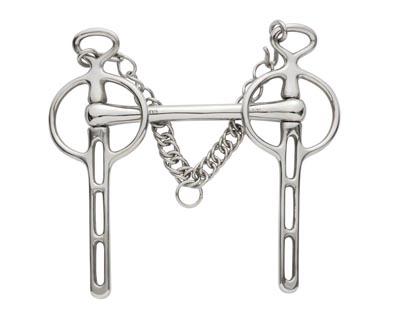A Bit on Bits
What is a Bit?
Answer: The usually metal part of a bride that is inserted in the horses mouth. Bits are used to control the horse through the exertion of pressure inside the horses mouth. There are hundreds of bit designs on the market for nearly every horse and need.
The Basic Snaffles (D-ring, O-ring, Full-cheek and Egg-butt)
- Uses – for a variety of events in both English and Western, however it is more popular among English riders. Ideal for the young horse that is being trained to use a bridle. Direct pressure without leverage is placed on the corners of the horse’s mouth.
- Design – simple and consists of a mouthpiece and bit rings. Designs of the mouthpiece and rings vary widely. Snaffle bit rings may be loose (which allows the mouthpiece to slide) or may be fixed. O-rings are shaped like an O, D-rings are shaped like a D. Full-cheek snaffles feature a spike above and below the ring, to prevent it from slipping through a horse’s mouth. Egg-butt snaffle rings have a design that is between an O and a D shape.
The Kimblewick
- Uses – The Kimblewick is a leverage bit. This bit is commonly used in general riding and provides more aids to a horse that may be a strong puller or needs a slight curb action to its lower head. They are illegal for some competition classes, such as dressage and show hunter, but are very useful for contact sports on horseback, such as polocrosse.
- Design – The Kimblewick features D-rings, bit shanks and a curb chain. The further the rein slides down the D-ring, the more leverage is applied. The curb chain prevents the bit from rotating too far in the horse’s mouth. When the reins are pulled back the bit applies pressure to the bars of the mouth, the poll, and the chin.
The Pelham
- Uses – Commonly used for schooling, polo and general riding, as long as the rider knows about using a curb bit and riding with double reins. The English Pelham bit somewhat mimics the action of the bridoon (small snaffle bit) and Weymouth (curb) bit combination used on a double bridle. This bit encourages proper head carriage. Pelhams may be used on horses that are unable to hold the two bits comfortably, or for convenience.
- Design – Pelham bits can feature either a solid or jointed mouthpiece. A large ring directly connects to the mouthpiece, where the snaffle reins are attached to. Curb reins attach to the next smallest ring of the shank (NOT the ring next the large ring). The curb chain under the horse’s chin prevents the bit from rotating too far and provides another pressure point in the horse’s mouth. There is a small lip strap on the bit that prevents the horse from attempting to nibble at the shanks.
The Curb
- Uses – The curb can be used by both English and Western riders, however it is much more commonly seen used among Western rider, for all event types. Curb bits are most appropriate for well-trained horses that respond to neck reining. Straight shanks work best with dressage horses while curved shanks are ideal for cutting and roping horses.
- Design – The curb bit places pressure on the bars, tongue and roof of the horse’s mouth. The curb strap allows for a rider’s signal to be felt over the horse’s poll and chin. The headstall and curb strap are attached to the top ring while the reins are attached to the bottom ring. Curb bits place a greater amount of leverage on the horse. Therefore, when using a curb the rider should ride with a loose rein and only light pressure should be used.
The Liverpool (Driving Bit)
- Uses – Very popular bit choice for driving, especially when working in teams.
- Design – The Liverpool is a leverage bit. That said, the farther down the shanks the reins are attached, the more leverage will be applied. The low port allows for more room for the horse’s mouth and prevents the horse from putting its tongue over the mouthpiece. Liverpool bits can feature hinged or fixed shanks. Alternatively, the reins can be attached directly onto the bit so that it can be used as a simple snaffle.
The Dexter Ring
- Uses – The Dexter ring bit is used in conjunction with a snaffle and is the most popular ring bit design of today. Most often used in horse racing and is useful for strong/spirited horses because of increased stopping and steering power.
- Design – The Dexter ring bit features a jointed snaffle mouthpiece and a ring that passes through the horse’s mouth and encircles the lower jaw. The snaffle portion of the bit can have rubber, plastic or metal coating and the ring itself is metal. The cheek pieces can be a variety of shapes.

